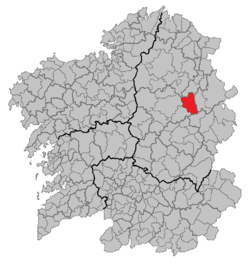
Galicia is an autonomous community of Spain and historic nationality under Spanish law. Located in the northwest Iberian Peninsula, it includes the provinces of A Coruña, Lugo, Ourense, and Pontevedra.

Lugo is a province of northwestern Spain, in the northeastern part of the autonomous community of Galicia. It is bordered by the provinces of Ourense, Pontevedra, and A Coruña, the principality of Asturias, the State of León, and in the north by the Cantabrian Sea.

Ourense is a province of Spain, in the southeastern part of the autonomous community of Galicia. It is bordered by the provinces of Pontevedra to the west, Lugo to the north, León and Zamora, to the east, and by Portugal to the south. With an area of 7,278 square km., it is the only landlocked province in Galicia. The provincial capital, Ourense, is the largest population centre, with the rest of the province being predominantly rural.

Ourense is a city and the capital of the province of Ourense, located in the autonomous community of Galicia, northwestern Spain. It is on the Camino Sanabrés path of the Way of St James, and is crossed by the Miño, Barbaña, Loña and Barbañica rivers. It is also known as A cidade das Burgas due to its hot springs, being one of the European cities with the greatest thermal heritage.

Lugo is a city in northwestern Spain in the autonomous community of Galicia. It is the capital of the province of Lugo. The municipality had a population of 100,060 in 2024, making it the fourth most populous city in Galicia.

Abadín is a municipality in the province of Lugo, Galicia, Spain. It covers 196.1 km2 and has a population of 3,250 for a population density of 16.57/km2. It resides in the region of Terra Cha.
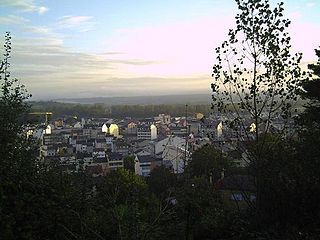
Sarria is a municipality in the province of Lugo, in the autonomous community of Galicia, northwestern Spain. It belongs to the comarca of Sarria. Sarria is the most populous town on the French Way in Galicia, with 13,700 inhabitants and the major is Carmen José Lòpez. It is head of the region and the most popular starting point for the Camino de Santiago; many pilgrims choose Sarria because the distance from this point to Santiago allows them to cover the necessary kilometers to reach the Compostela. King Alfonso IX of León died in Sarria in 1230 while making a pilgrimage to Santiago de Compostela.
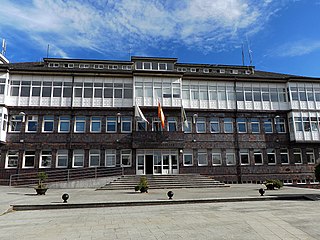
Vilalba is a municipality in the province of Lugo, in the autonomous community of Galicia, Spain. It belongs to the comarca of Terra Chá. It is located on the left bank of the river Ladra, one of the headstreams of the Miño.

Castro de Rei, is a municipality in the province of Lugo, in the autonomous community of Galicia, Spain. It belongs to the comarca of Terra Chá. The population in 2009 was 5,685 people according to INE.

A Fonsagrada is a town and municipality in the province of Lugo in the autonomous community of Galicia in northwest Spain which is 25 miles east-north-east of Lugo by road. Its population in 2004 was 5,007. A Fonsagrada is situated 3,166 feet (965 m) above sea-level on the watershed between the rivers Rodil and Suarna. Historically it was an important market for a variety of agricultural produce, and it manufactured linen and frieze for local trading.

Os Ancares is a comarca in the Galician Province of Lugo. The overall population of this local region is 13,888 (2005). It is formed by the municipality of Candín with two slopes, Sil and Navia, and separated by the Ancares pass.
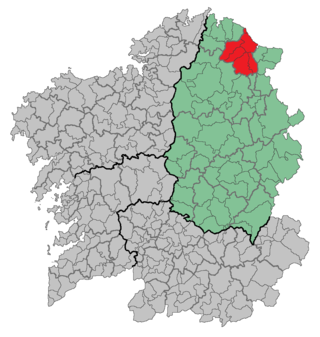
A Mariña Central is a comarca in the Galician Province of Lugo. The overall population of this local region is 28,955 (2019). This region is a political-administrative division of A Mariña de Lugo macro-region. To the north and northeast the region borders the Bay of Biscay, on the northwest with La Mariña, to the west and south by the Terra Chá, Meira on the southeast and east with A Mariña Oriental.

As Nogais is a municipality in the province of Lugo, in the autonomous community of Galicia, Spain. It belongs to the comarca of Os Ancares. It is 57 kilometers from the city of Lugo. It had a population of 1,381 in 2009 according to the Municipal Register of Inhabitants.
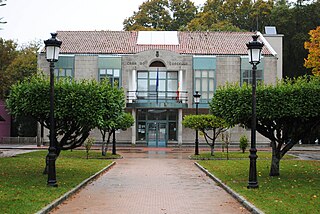
O Saviñao is a Concello (council) in the province of Lugo, Galicia belonging to the district of Terra de Lemos. The main town for the council is Escairón.

Ribeira Sacra is a Spanish Denominación de Origen Protegida (DOP) for wines located in the south of the province of Lugo and in the north of the province of Ourense, in Galicia, Spain. It extends over the territories of 20 different municipalities that make up a zone also called Ribeira Sacra, which could be translated as "Sacred Riverbank". Vineyards are planted on the steep slopes of the valleys and canyons of the rivers Miño and Sil. The area acquired official Denominación de Origen status in 1996.

A Pontenova is a municipality in the province of Lugo, in the autonomous community of Galicia, Spain. It belongs to the comarca of A Mariña Oriental. It has a population of 3199 and an area of 136 km².
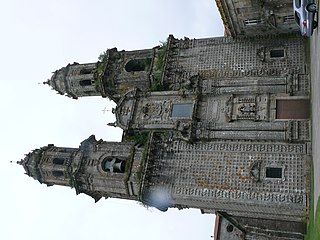
Sobrado is a municipality in the province of A Coruña, in the autonomous community of Galicia, Spain. It has a population of 2,087 and an area of 121 km2. Sobrado is well known because of Sobrado Abbey, a Trappist monastery. The town is known by the name Sobrado dos Monxes in Galician or Sobrado de los Monjes in Spanish but the official name is just Sobrado.

Taramundi is a municipality in the Principality of Asturias, Spain. It neighbors on the north side with San Tirso de Abres and Vegadeo, on the east side with Villanueva de Oscos and Vegadeo, on the south side with Santa Eulalia de Oscos and A Pontenova (Lugo), and on the west side with Lugo.
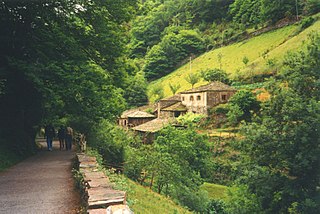
The Turia Valley is a small valley on the western border of the Cantabrian Mountains in the northwest of Spain which is close to beaches and is divided by two autonomous communities: Asturias and Galicia. It consists of an area of 90 km2, 3,910 inhabitants and is 200 m above sea level. The two main towns are A Pontenova (Galicia) and Taramundi (Asturias).
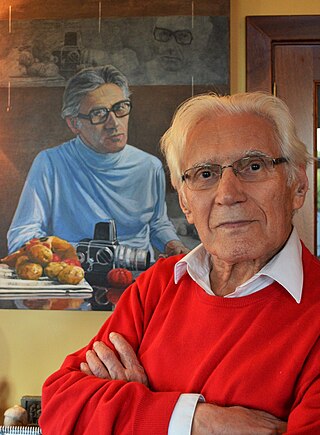
Baldomero Pestana was a Spanish photographer, painter, and figurative artist.

